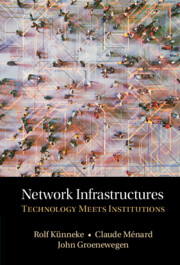Book contents
- Network Infrastructures
- Network Infrastructures
- Copyright page
- Dedication
- Contents
- Figures and Tables
- Preface
- Introduction
- Part I Conceptual Framework
- 1 Network Infrastructures
- 2 Institutional Embeddedness
- 3 Technology in Three Dimensions
- 4 Bringing Together Two Worlds Apart
- Part II Empirical Explorations
- Glossary
- References
- Index of Names
- Subject Index
4 - Bringing Together Two Worlds Apart
from Part I - Conceptual Framework
Published online by Cambridge University Press: 02 December 2021
- Network Infrastructures
- Network Infrastructures
- Copyright page
- Dedication
- Contents
- Figures and Tables
- Preface
- Introduction
- Part I Conceptual Framework
- 1 Network Infrastructures
- 2 Institutional Embeddedness
- 3 Technology in Three Dimensions
- 4 Bringing Together Two Worlds Apart
- Part II Empirical Explorations
- Glossary
- References
- Index of Names
- Subject Index
Summary
This chapter assesses factors of alignment between institutions and the technology of network infrastructures, and how to achieve or restore alignment. This is a significant challenge, since institutions and technologies are “two worlds apart” that need to be brought together. This is accomplished in three steps. First, we specify how technology and institutions are interrelated at three layers of analysis: structure, governance, and transactions. By connecting these three layers with the services to be provided, we are able to identify the conditions to be fulfilled within each layer, in order for the critical functions to be safeguarded. Second, we focus on characterizing different problems of coordination that develop either within the technological dimension, or within the institutional dimension. Our underlying argument is that modalities of coordination adopted to solve these problems may partially differ, depending on whether we are looking at the technological side or the institutional side, but that they ultimately need to share compatible characteristics if alignment is to be reached and the critical functions satisfied. Third, when disturbances of different orders challenge the existing arrangements, we provide indications as to how alignment can be reached, or reestablished, at the three layers we have identified.
Keywords
- Type
- Chapter
- Information
- Network InfrastructuresTechnology meets Institutions, pp. 93 - 122Publisher: Cambridge University PressPrint publication year: 2021

